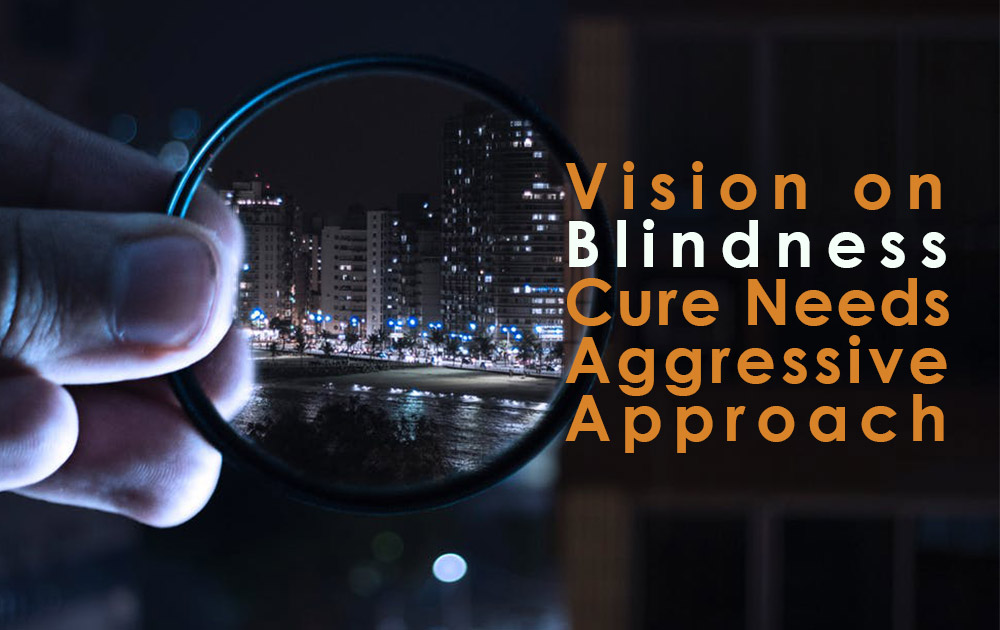Despite current measures, blindness in the world is increasing by 1 to 2 million cases per year – the result is a 100% increase in world blindness by the year 2020 unless more aggressive measures are in place.
The World Health Organization (WHO) estimates that 80% of visual impairment is either preventable or curable with treatment. As of 2015, there were 940 million people with some degree of vision loss. 246 million had low vision and over 45 million were blind with 60% of these individuals living in China, India and Sub-Saharan Africa. Majority of people with poor vision reside in the developing world and are over the age of 50 years. Visual impairments have considerable economic costs both directly due to the cost of treatment and indirectly due to decreased ability to work.
Also Read: Artificial Retinas

India is home to over 8 million blind people, another 50 million have moderate to severe vision impairment. The loss of sight causes enormous human suffering for the affected individuals and their families. It also represents public health, social and economic problem for countries, especially the developing ones, where 9 out of 10 of the world’s blind live.
Visual impairment, also known as vision impairment or vision loss, is a decreased ability to see to a degree that causes problems not fixable by usual means. The term blindness is used for complete or nearly complete vision loss. Visual impairment may cause people difficulties with normal daily activities such as driving, reading, socializing and walking.
The most common causes of visual impairment globally are uncorrected refractive errors (43%), cataracts (33%), and glaucoma (2%). Refractive errors include nearsighted, farsighted, presbyopia and astigmatism. Cataracts are the most common cause of blindness. Other disorders that may cause visual problems include age-related macular degeneration, diabetic retinopathy, corneal clouding, childhood blindness, and a number of infections. Screening for vision problems in children may improve future vision and educational achievement.
According to Mr. J.P. Nadda, Minister of Health & Family Welfare, “The central government is committed, inter alia, to developing and strengthening the strategy of NPCB towards ‘Eye Health for All’ by way of preventing visual impairment through provisioning of comprehensive universal eyecare services and quality service deliveries”.
Mr. Ashwani Kumar Choubey, Minister of State for Health & Family Welfare says, “Despite greater awareness and policy interventions, blindness in the world is increasing phenomenally and according to WHO unless more aggressive measures are taken, there may be 100 percent increase in blindness by the year 2020. This is highly alarming & needs drastic wholesale measures”.
This calls for reducing the backlog of avoidable blindness through identification and treatment of curable blind at primary, secondary and tertiary levels, based on an assessment of the overall burden of visual impairment in the country.
Optometrists as the first point of contact for primary eye care services and equipped with the requisite knowledge and expertise, thus create a huge impact in preventing this avoidable blindness & vision impairment.
Mr. Santosh Kumar Gangwar, Minister of State, Labour & Employment says, “The traditional core of optometry has been the assessment of visual health and management strategies centered on spectacle lens and contact lens therapy. This core, however, has expanded greatly over the past century to include a number of other important services. Today’s optometry professionals are well educated and well trained to provide the full range of services thereby enhancing vision, protecting the health and preventing avoidable blindness due to refractive errors and visual impairment by over 80%”.
Mr. Ashok Siddharth, MP (Rajya Sabha) & Member Parliamentary Standing Committee on Health and Family Welfare noted that “Optometrists today provide approximately two-thirds of all eye care in the country and are prepared to meet the growing needs of the public”.
“The role of optometrists in tackling the problem of refractive error and visual impairment is important. Timely detection of refractive errors and their correction by spectacle can not only improve the child’s potential during the formative years but also prevent complications associated with uncorrected refractive error” said Dr. Promila Gupta, Director General of Health Services, Ministry of Health & Family Welfare.
The hard work and devotion of Indian optometrists within their profession and around their communities thus provide an invaluable service to millions of Indian citizens. Without their dedication, desire to serve the community and professionalism in delivering excellent eye care services; our fellow countrymen would not enjoy the optimal vision they have today.
In the backdrop of the above, Indian Optometric Association, the apex industry association representing approximately 12,000 Doctors of Optometry, optometry students, and paraoptometric assistants accessible to the common public.
Speaking on the occasion, Mr. Anil Tyagi, President, Indian Optometric Association said “AIOC has become synonymous with providing participants from across India & abroad, an excellent opportunity to share their research, experiences & optometry advancements. They sought to generate, from the conference, a better understanding of the role of optometry in eradicating the 80 percent avoidable blindness in India and other developing countries. The key to success would be making primary eye-care services easily accessible &economicaaly viable for a common public”
AIOC 2018 Organising Secretary, Dr. Subodh Dixit said: “the 37th AIOC 2018 conference spread over 16 interactive sessions & 10 workshops showcased over 75 prolific speakers, nearly 600 plus industry delegates & 20+ exhibitors; thus, offering exceptional value both as a traditional technical conference & a global networking forum”.
Dr. Rajeev Prasad, Conference Chairman, AIOC 2018 added that “the All India Optometry Conference (AIOC 2018) engaged collective experience & expertise of practitioners, optometrists, industry partners, academia, and technology organizations to discuss, deliberate, share & learn the best of practices and leadership traits”.

About InnoHEALTH Magazine
InnoHEALTH Magazine is an RNI (Registrar of Newspapers for India) registered magazine initiated in July 2016 under the InnovatioCuris banner. This magazine focuses on healthcare innovations and has been termed one of its kind in India. The articles composed on the magazine are curated on this website.
Categories
 Get instant updates through our RSS feed
Get instant updates through our RSS feed
- Are Nurses Ready for AI? What’s Missing in Our Hospitals
- Herbal Innovation for Diabetes: Dr. Priyanka Sharma on Medicinal Snacks and Lifestyle Wellness
- Balancing Technology and Compassion: Dr. Ramindra Kalra on the Future of Nursing in the AI Era
- Reimagining Indian Healthcare: A Conversation with Dr. Adil Khan
- Advances in Mental Health: Technology’s Role in Stress Management
Recent popular posts
Head office address
A-37
Trimala Capital Venture
Sector 63, Noida
Uttar Pradesh – 201301
India
Trimala Capital Venture
Sector 63, Noida
Uttar Pradesh – 201301
India
Phone number
+91 9711777328
Email address
Tags
AI (42)
AIIMS (13)
Artificial Intelligence (53)
Ayushman bharat (14)
Blood Pressure (13)
Cancer (15)
COVID-19 (33)
Depression (17)
Diabetes (41)
Digital Health (18)
Drugs (12)
FDA (16)
health (28)
healthcare (99)
Healthcare Delivery (20)
Healthcare Innovation (26)
Hospitals (13)
India (26)
innohealth (19)
InnoHEALTH Magazine (43)
innovatiocuris (50)
innovation (50)
Internet of Things (20)
IoT (20)
IT (12)
Lifestyle (21)
Machine Learning (26)
Medical devices (19)
Medication (12)
Medicine (21)
Mental Health (20)
MRI (13)
Non Communicable Diseases (14)
Obesity (17)
pandemic (12)
Public health (27)
Startup (18)
Stress (15)
Technology (58)
Telemedicine (16)
Treatment (21)
Tuberculosis (14)
WHO (30)
World Health Organization (17)
Yoga (16)
